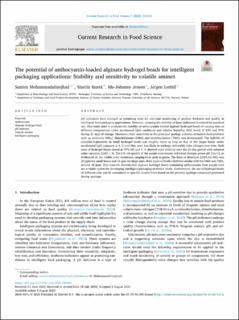| dc.contributor.author | Mohammadalinejhad, Samira | |
| dc.contributor.author | Kurek, Marcin | |
| dc.contributor.author | Jensen, Ida-Johanne | |
| dc.contributor.author | Lerfall, Jørgen | |
| dc.date.accessioned | 2023-09-01T05:37:54Z | |
| dc.date.available | 2023-09-01T05:37:54Z | |
| dc.date.created | 2023-08-07T09:02:48Z | |
| dc.date.issued | 2023 | |
| dc.identifier.issn | 2665-9271 | |
| dc.identifier.uri | https://hdl.handle.net/11250/3086753 | |
| dc.description.abstract | pH indicators have emerged as promising tools for real-time monitoring of product freshness and quality in intelligent food packaging applications. However, ensuring the stability of these indicators is critical for practical use. This study aims to evaluate the stability of anthocyanins-loaded alginate hydrogel beads of varying sizes at different temperatures under accelerated light conditions and relative humidity (RH) levels of 53% and 97% during 21 days of storage. Moreover, their sensitivity to the principal spoilage volatiles of muscle food products such as ammonia (NH3), dimethylamine (DMA) and trimethylamine (TMA) was investigated. The half-life of cyanidin-3-glucoside in small hydrogel beads was roughly twice as long as that of the larger beads under accelerated light exposure at 4 °C and they were less likely to undergo noticeable color changes over time. Both sizes of hydrogel beads stored at 97% RH and 4 °C showed color stability over the 21-day period with minimal color variation (|ΔE| ≤ 3). The UV–vis spectra of the purple corn extract exhibited changes across pH 2 to 12, as evidenced by the visible color variations, ranging from pink to green. The limit of detection (LOD) for NH3 was 25 ppm for small beads and 15 ppm for large ones. Both types of beads exhibited similar LOD for DMA and TMA, around 48 ppm. This research showed that alginate hydrogel beads containing anthocyanins from purple corn are a viable option for developing intelligent packaging of muscle foods. Furthermore, the use of hydrogel beads of different sizes can be customized to specific muscle foods based on the primary spoilage compound generated during spoilage. | en_US |
| dc.language.iso | eng | en_US |
| dc.publisher | Elsevier | en_US |
| dc.rights | Attribution-NonCommercial-NoDerivatives 4.0 Internasjonal | * |
| dc.rights.uri | http://creativecommons.org/licenses/by-nc-nd/4.0/deed.no | * |
| dc.title | The potential of anthocyanin-loaded alginate hydrogel beads for intelligent packaging applications: Stability and sensitivity to volatile amines | en_US |
| dc.title.alternative | The potential of anthocyanin-loaded alginate hydrogel beads for intelligent packaging applications: Stability and sensitivity to volatile amines | en_US |
| dc.type | Journal article | en_US |
| dc.description.version | publishedVersion | en_US |
| dc.source.volume | 7 | en_US |
| dc.source.journal | Current Research in Food Science | en_US |
| dc.identifier.doi | https://doi.org/10.1016/j.crfs.2023.100560 | |
| dc.identifier.cristin | 2165131 | |
| cristin.ispublished | true | |
| cristin.fulltext | original | |

